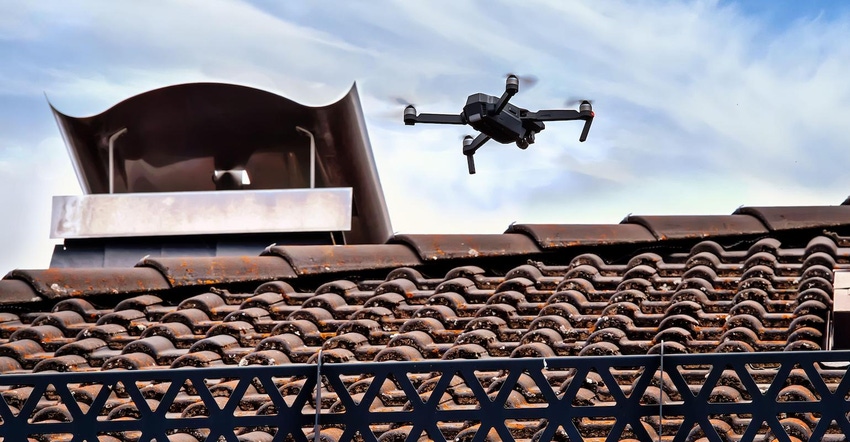4 Simple, Cost-Effective Tech Solutions That Up Efficiency
These are some of the investments digital-forward roofing companies are finding offer the best bang for the buck—with minimal training and set up.
March 28, 2023

John Kiesel recently held a seminar at the International Roofing Expo on roofing technology that was standing room only.
“People were lined up at the door just trying to listen,” said Kiesel, president of Division 7 Roofing and Imagine Technologies Group as well as a member of the Roofing Technology Think Tank, or RT3.
Does that mean the roofing and exteriors industries have finally stopped dragging their feet and fully embraced technology and digital solutions? Hardly.
“I talk to a lot of other roofers out there and smaller companies where the owners are still getting on the roofs—they’re not embracing technology at all. They barely can work email,” said Brandon Foote, owner and president of Advanced Roofing & Construction, which made the 2022 Inc. 5000 list with an impressive 362% growth rate. He credits much of that explosive growth to tech efficiencies.
But Foote and others understand the reluctance some of their peers have towards technology. “Adopting new technology is often an uphill battle for a small business that has to weigh the added costs, staff's time and ability to master the technology, and the ROI on the capital investment,” said Wendy Dishman, controller for Cross Timbers Roofing.
That said, tech adopters like Foote and Kiesel praise the fast ROI and massive efficiency leaps in productivity, estimating and inventorying—50% or more in some cases—that technology has produced for their companies. They also stress that roofers can ease into tech investments with simple solutions that don’t require a lot of upfront cost or training.
Here’s a look at four low-cost, high-value tech investments, recommended by Foote and Kiesel, roofing and exteriors businesses can make to get the digital ball rolling:
1. Drones
Roofing and exteriors are a natural target for these flying hardware marvels, Kiesel has found. “People think drones are this thing that flies up and takes pictures or are just for kids,” he said. “But they can do so much more.” For example:
Photogrammetry is the art and science of 3D imagery and drones make it possible to use this technique. Kiesel uses software called Optelos that creates a 3D map of roofs for virtual inspections and instant estimating, which he figures has doubled the efficiency of the process.
Attaching thermal cameras to drones and flying them over roofs is a powerful way to detect moisture quickly and accurately in a roof assembly. Kiesel said the technology has allowed his firm to self-perform this function rather than outsource it to a third party—saving both time and money.
Attaching active and passive radio frequency identification tags to field materials allows a drone with an RFID tag reader to quickly and accurately inventory site materials. The information is uploaded to a central database along with cost calculations. “You just fly it over a roof, and it calculates all the materials on the project in 15 minutes, without worrying about, ‘did I count it, or did I miss it,’” Kiesel said.
2. Slack communications platform
This email alternative has been around for a while, but Foote said he only recently discovered how powerful it could be for his firm. That’s because Slack takes communication such as emails and texts and puts it in one place that’s easily searchable, so institutional knowledge doesn’t get siloed on devices.
“It’s like, ‘I know I’ve already asked this question,’ and with Slack, you can just search for it,” he said.
Foote also likes the different channels he can create for his team members, such as ventilation or learning time. “It’s really picked up traction fast. People get into it,” he said. “And it keeps them set into the culture you’re trying to create.”
Next, Foote plans to experiment with rewarding employees through Slack with points for small accomplishments that can be cashed out for gift cards. “It allows you to bonus people on the spot, and show that you appreciate what they do,” he said.
3. Roofing-specific operational tech platform
Both Foote and Kiesel urged companies to make the transition from paper and Excel to a dedicated system that often combines CRM, estimating, field management, workflow and productivity into one digital platform. Foote uses JobProgress, while Kiesel likes Dataforma and RoofLogic. Regardless of the system, Kiesel said going from hardcopy to digital is transformational.
“When you have all your historical data contained in a single source, you’re able to be more efficient and effective,” he said. “I’m at least three times more efficient because of this platform, and I’m more professional when delivering reports and invoices. It’s definitely a differentiator when it comes to winning more jobs.”
While tech investment is important, Foote said some companies may simply need to look closer into the hardware and software they currently use.
“Instead of trying to constantly find a new solution, you need to dig back into what you already have,” he said. “A lot of times, you’re paying for plenty of features you’re not even using.”
4. Photo-based project app
As the name implies, CompanyCam software is all about photos. The maker says it was built by contractors for contractors to document all parts of a project that can be viewed anytime, anywhere by you and your team. But Foote said the app is much more powerful than that. That’s because CompanyCam also allows users to create simple checklists that turn the app into a “dummy-proof” job manager, he said.
In addition, each photo is GPS stamped and stored in a searchable database. Foote said that’s been invaluable when it comes to damage claims and insurance work. “It costs me $1,400 a year for eight guys, and I easily save that alone in false accusations of damages,” he said.
About the Author(s)
You May Also Like




